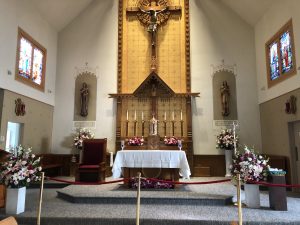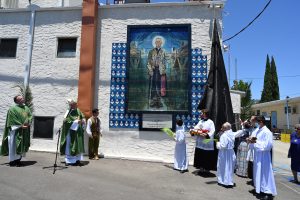After 80 years on St. George’s Street in the Los Feliz area of Los Angeles, the parish community St. Casimir Catholic Church has a lot to celebrate.
Most recently the parish, which describes itself as “the sanctuary of Lithuanian immigrants and their families on the West Coast,” witnessed the June 26 reopening of their church after extensive renovations.
Parishioners were joined by a familiar face: one-time parishioner Archbishop Gintaras Grušas of Vilnius, Lithuania, who traveled to Los Angeles to preside at the day’s celebrations.
Born in Washington, D.C., to Lithuanian immigrants, Grušas was an active parishioner at St. Casimir while obtaining his degree in mathematics and information technology at UCLA before working for IBM. Last year, he was elected by his brother bishops as the president of the Council of European Bishops’ Conferences.

“I’m very thankful for my American experience and all that it gave me,” Grušas told Catholic News Agency last year. “I’m also very thankful for my Lithuanian heritage and roots. And I think it’s a blessing to have the mix.”
Those Lithuanian roots are on full display in the renovations of St. Casimir, which were completed as part of the Called to Renew campaign launched by the Archdiocese of Los Angeles in 2018. The church raised more than $215,000 to complete the renovations as part of the archdiocesan initiative to bring spiritual renewal through the renovation of sacred spaces.

The result was the creation of a space to serve as “a reflection and story of people who fled from Soviet oppression while keeping the faith in their new country,” according to Vidal Aguas, Called to Renew coordinator for St. Casimir.
During the special Mass June 26, Archbishop Grušas dedicated the church’s new altar, reminding the faithful in his homily that “the altar represents Christ, where the community participates in the sacrifice of the Mass and where we are invited in thanksgiving to the table of the Lord.”
The church’s grand reopening was scheduled to coincide with the fifth anniversary of the beatification of Blessed Teofilius Matulionis, a predecessor of Grušas as archbishop of Vilnius and the first recognized Catholic martyr under Soviet occupation of Lithuania.

A new mural honoring the martyred archbishop was also unveiled during the June 26 festivities. Called the first of its kind outside Lithuania, the mural of Blessed Teofilius was designed by Mexican-American artist Lalo Garcia, with tiles sourced from Uriarte, a 200-year-old manufacturer in Puebla, Mexico.
Other new items of sacred art include a map of Lithuania superimposed with images of six holy men and women with connections to the country, including Saint Faustina Kowalska and her spiritual director, Blessed Michael Sopocko, who met while the nun was assigned to a convent in Vilnius.
Another mural of two crowns welcomes visitors as they enter the church. One of the crowns represents the church’s namesake, who was a fifteen-century Grand Duchy of Lithuania, while the other honors Ausros Vartu Marija (Our Lady Gate of the Dawn), a miraculous icon of Mary who Lithuanian Catholics honor as Queen of Poland and Grand Duchy of Lithuania.

The church also allows the faithful to make a spiritual pilgrimage to the Lithuanian “Hill of Crosses,” the site of thousands of crosses left by pilgrims and artists in remembrance of the dead. Despite several attempts by the Soviets to destroy the place of prayer, the Hill of Crosses continues to be a place of hope and healing for pilgrims to Vilnius and is listed on the UNESCO Intangible Cultural Heritage List.
Each of these new pieces of sacred art serve as a celebration of the community’s history, but for Aguas they are also a reminder of the faithfulness of Catholic Lithuanians in the face of turmoil caused by the ongoing Russian invasion of Ukraine.
“We pray that [Lithuanians] do not suffer religious persecution again, as Ukraine defends its freedom,” he said. “Ukraine and Lithuania were both under Russian occupation.”Ar

